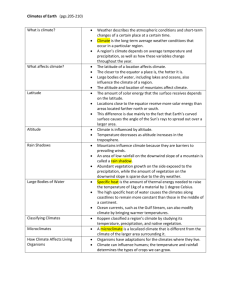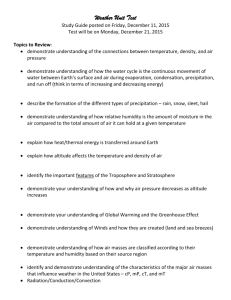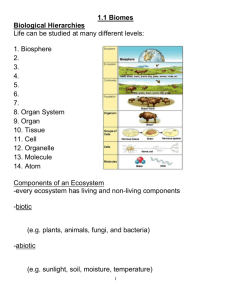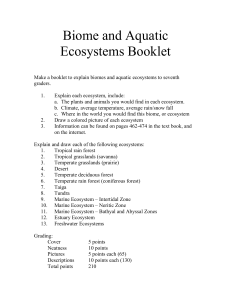Ecosystem Factors: Precipitation & Altitude Worksheet
advertisement
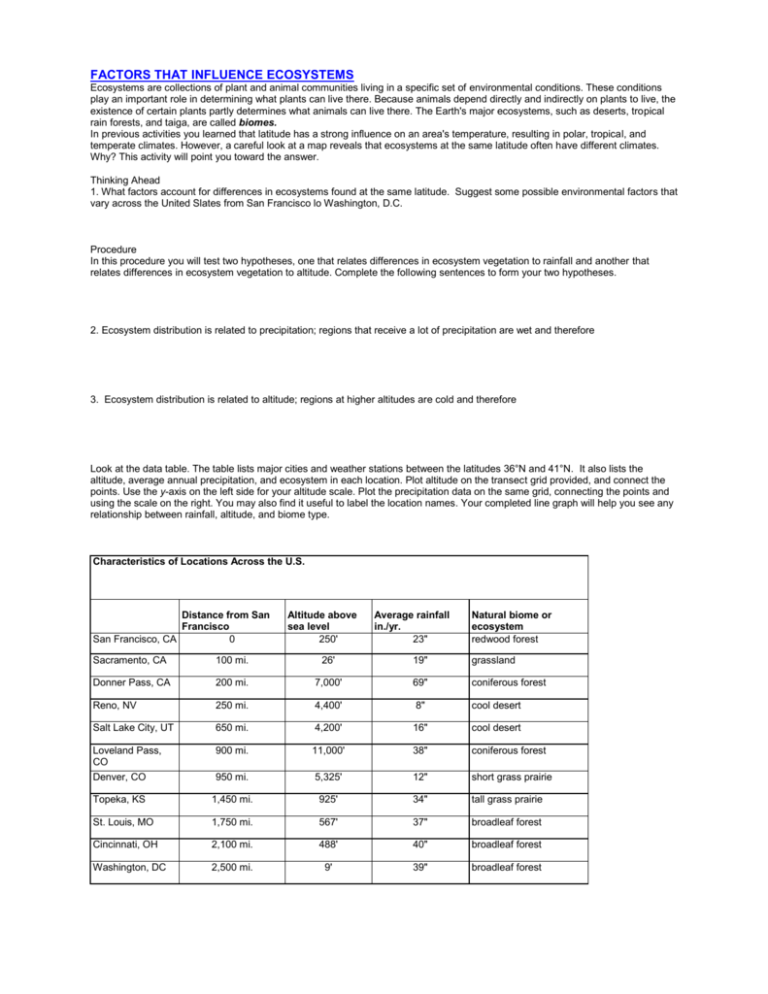
FACTORS THAT INFLUENCE ECOSYSTEMS Ecosystems are collections of plant and animal communities living in a specific set of environmental conditions. These conditions play an important role in determining what plants can live there. Because animals depend directly and indirectly on plants to live, the existence of certain plants partly determines what animals can live there. The Earth's major ecosystems, such as deserts, tropical rain forests, and taiga, are called biomes. In previous activities you learned that latitude has a strong influence on an area's temperature, resulting in polar, tropical, and temperate climates. However, a careful look at a map reveals that ecosystems at the same latitude often have different climates. Why? This activity will point you toward the answer. Thinking Ahead 1. What factors account for differences in ecosystems found at the same latitude. Suggest some possible environmental factors that vary across the United Slates from San Francisco lo Washington, D.C. Procedure In this procedure you will test two hypotheses, one that relates differences in ecosystem vegetation to rainfall and another that relates differences in ecosystem vegetation to altitude. Complete the following sentences to form your two hypotheses. 2. Ecosystem distribution is related to precipitation; regions that receive a lot of precipitation are wet and therefore 3. Ecosystem distribution is related to altitude; regions at higher altitudes are cold and therefore Look at the data table. The table lists major cities and weather stations between the latitudes 36°N and 41°N. It also lists the altitude, average annual precipitation, and ecosystem in each location. Plot altitude on the transect grid provided, and connect the points. Use the y-axis on the left side for your altitude scale. Plot the precipitation data on the same grid, connecting the points and using the scale on the right. You may also find it useful to label the location names. Your completed line graph will help you see any relationship between rainfall, altitude, and biome type. Characteristics of Locations Across the U.S. Distance from San Francisco San Francisco, CA 0 Altitude above sea level 250' Average rainfall in./yr. 23" Natural biome or ecosystem redwood forest Sacramento, CA 100 mi. 26' 19" grassland Donner Pass, CA 200 mi. 7,000' 69" coniferous forest Reno, NV 250 mi. 4,400' 8" cool desert Salt Lake City, UT 650 mi. 4,200' 16" cool desert Loveland Pass, CO Denver, CO 900 mi. 11,000' 38" coniferous forest 950 mi. 5,325' 12" short grass prairie Topeka, KS 1,450 mi. 925' 34" tall grass prairie St. Louis, MO 1,750 mi. 567' 37" broadleaf forest Cincinnati, OH 2,100 mi. 488' 40" broadleaf forest Washington, DC 2,500 mi. 9' 39" broadleaf forest Precipitation Altitude Distance 4. Is there a definite trend in precipitation levels from Denver to San Francisco or from Denver to Washington, D.C.? If so, describe it. 5. How do mountain ranges affect precipitation? Give an example that supports your answer. 6. What kinds of ecosystems occur in areas of high and low precipitation? 7. Is precipitation level or altitude the more important factor in determining an area's ecosystem? Is there an interaction between these two factors? Explain. 8. Does the data support or refute your hypotheses about the effect of precipitation and altitude on an ecosystem type? 9- Refer to the world biome map (Figure 6-16) on page 111 in your textbook, and examine the ecosystem patterns of the Eurasian continent. What do you infer about the distribution of rainfall in Eurasia?


